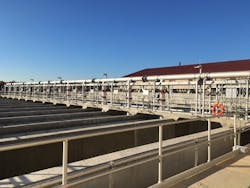Denitrification & Filtration System Removes Nitrogen & Suspended Solids in One Step
The Tetra Denite system combines denitrification and filtration for the effective removal of nitrate-nitrogen and suspended solids in a single treatment step. The combined fixed-film biological denitrification process plus Tetra DeepBed filters can easily meet <2 nephelometric turbidity units or <5 mg/L total suspended solids (<2 mg/L typical). Due to the filter’s high loading capacity, the percent of dirty backwash water return is less than 4% (<2% typical) of the plant’s forward flow. The small-footprint system integrates well with other plant treatment processes.
Three components make the Tetra Denite system unique. First, the patented Tetra Snap-T underdrains support the media and, during backwash, start the distribution of air and water. Second, the mono-media sand has a low uniformity coefficient, a high sphericity and a high Mohs hardness, providing a system that can operate for decades with little or no media loss or degradation. Third, the proprietary TETRAPace algorithm controls the flow of supplemental carbon to the filter, optimizing carbon usage and minimizing residual total organic carbon in the treated effluent water.
More than 20 wastewater treatment plants in the Chesapeake Bay watershed—and hundreds more around the world—are using the Tetra Denite filter technology to meet stringent permit regulations of 3 mg/L total nitrogen and 0.3 mg/L total phosphorus. The Back River Wastewater Treatment Plant Denite installation on the outskirts of Baltimore, currently in the startup process, is one of the largest denitrification filters in the United States, with an average daily flow of 188 million gal per day (mgd) and peak flow of a 300 mgd.
